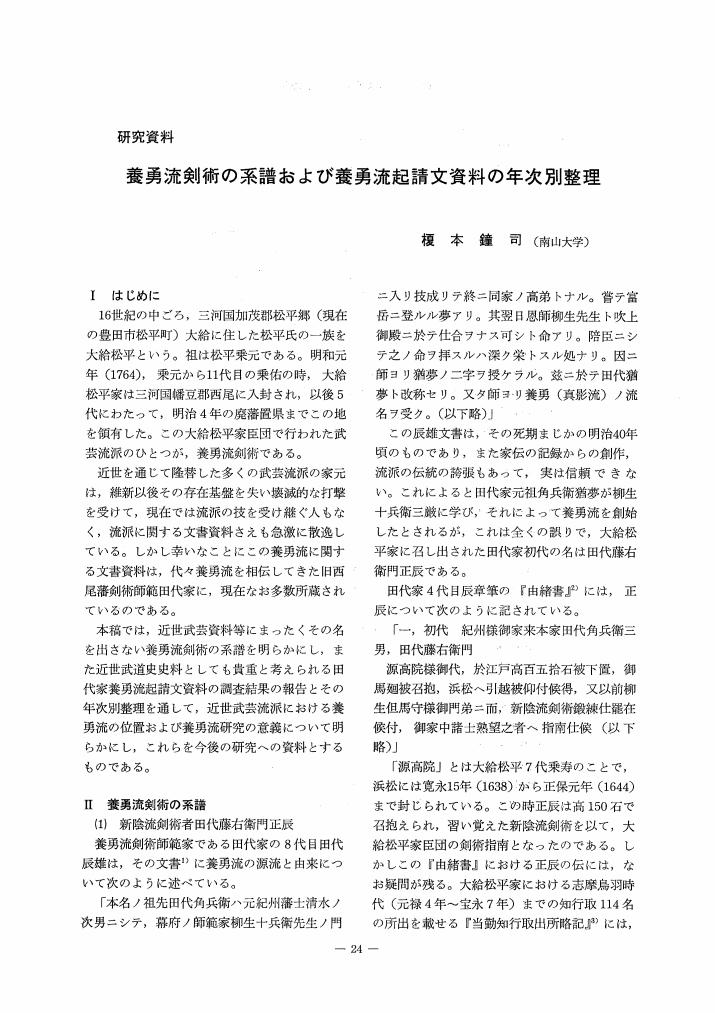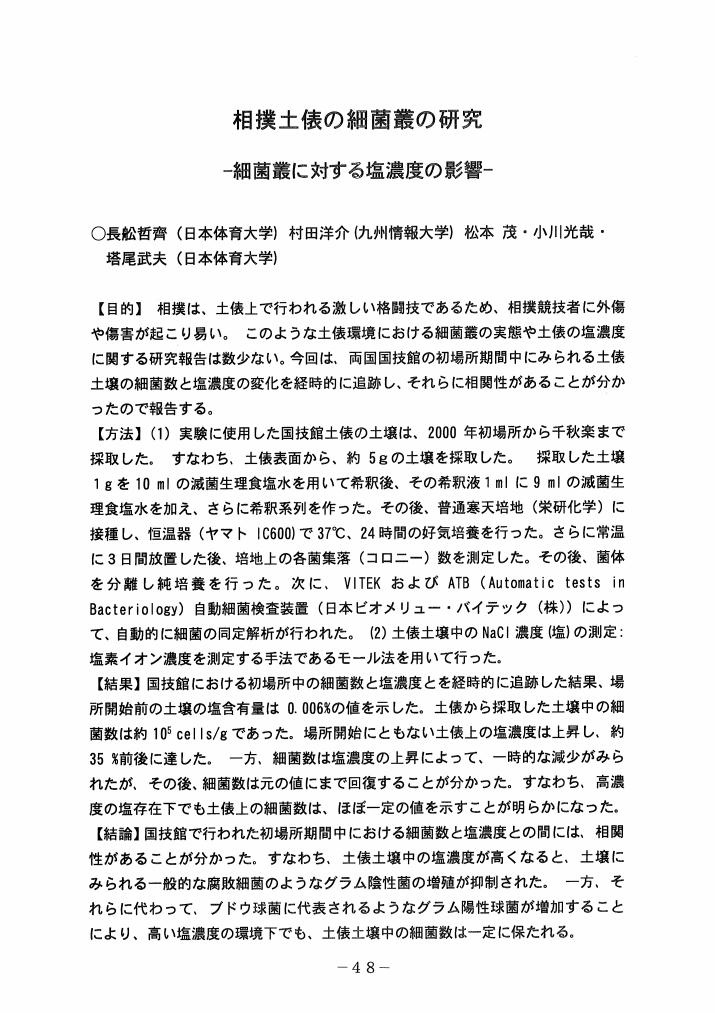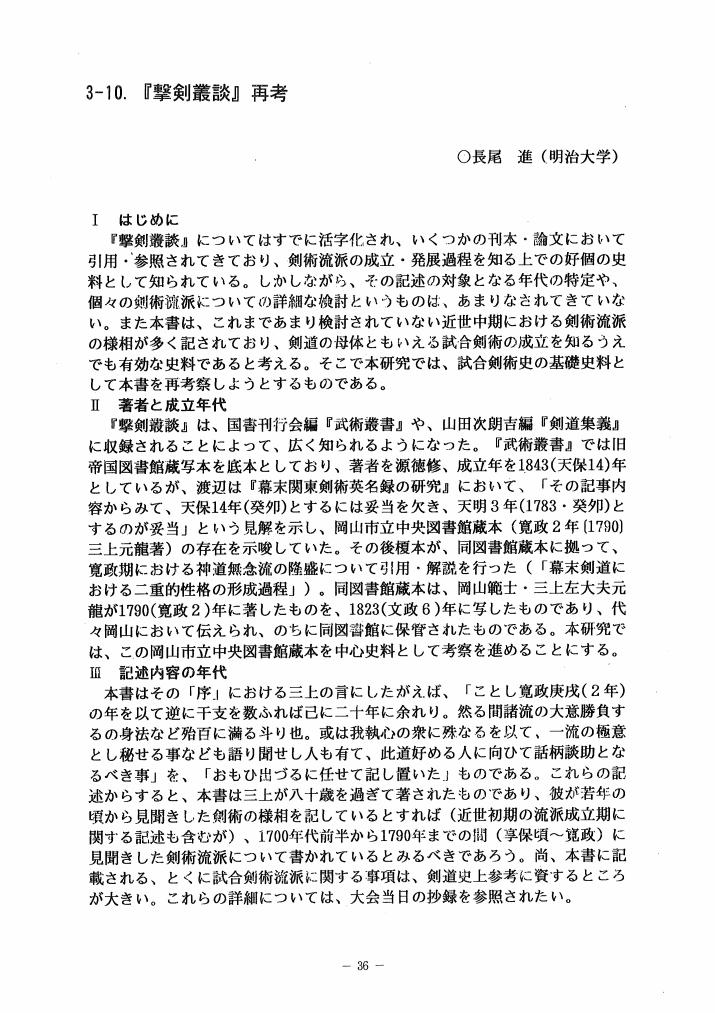1 0 0 0 OA 柔道の競技分析的研究 ―男子と女子の競技内容の比較―
1 0 0 0 OA 幕末関東剣術流派伝播形態の研究(2)
- 著者
- 中村 民雄
- 出版者
- 日本武道学会
- 雑誌
- 武道学研究 (ISSN:02879700)
- 巻号頁・発行日
- vol.30, no.Supplement, pp.51, 1997 (Released:2012-11-27)
1 0 0 0 OA 富山藩における武術教育II―四心多久間見日流和について―
- 著者
- 石黒 光祐
- 出版者
- 日本武道学会
- 雑誌
- 武道学研究 (ISSN:02879700)
- 巻号頁・発行日
- vol.30, no.Supplement, pp.39, 1997 (Released:2012-11-27)
1 0 0 0 OA 日本統治下台湾における弓道の導入と普及実態:弓道団体の進出を中心として
- 著者
- 五賀 友継 洪 子甯 松尾 牧則
- 出版者
- 日本武道学会
- 雑誌
- 武道学研究 (ISSN:02879700)
- 巻号頁・発行日
- vol.54, no.2, pp.87-102, 2022-03-31 (Released:2022-04-07)
- 参考文献数
- 90
The aim of this study was to clarify how kyudo was introduced and disseminated in Taiwan during the period of Japanese rule from 1895 to 1945.The first approach in investigating how kyudo began in Taiwan was by analyzing the local newspaper articles published during the period. It was found that the very first “Daikyujo” was established in Taipei in 1896, where kyudo activities first appeared. Some of the “Daikyujo” in this early period were for the purpose of physical exercise and training, while others were similar to “Yabaeigyo”, where the customers were charged to do kyudo as a form of entertainment.Next, understanding how the foundation was laid for the spread of kyudo in Taiwan was conducted by researching the role that the Dai Nippon Butoku Kai (DNBK) and the Dai Nippon Kyudo Kai (DNKK) played at the time. In the Taiwan branch of DNBK, the department of kyujutsu was established at the Taipei Chihou Iinbu (Taipei Regional Committee), which was the predecessor of the Taiwan branch of the DNBK, in 1901. This marked the beginning of kyudo practice on the island. However, the kyujutsu department was transferred out of the DNBK to Taiiku Club in 1903 and was temporarily separated from the DNBK. After the dissolution of Taiiku Club in 1916, it returned to the DNBK. Around the same time, the DNKK established its first branch in Takao (Kaohsiung) in 1915, but local promotion activities only began in earnest from 1924, after the visit of Kako NEYA, the founder of the DNKK. Subsequently, Seiko OIZUMI, a master of the DNKK, was stationed in Taiwan and further promoted the spread of kyudo.Lastly, the geographical locations and establishment timeline of the Kyudo group, mainly established by the DNBK and DNKK in Taiwan over the period of Japanese rule, were analyzed to identify the extent of the spread of kyudo in the region at the time. It was found that Kyudo group was not only established in urban areas on the west coast of the main island, but also on the less populated east coast, central mountainous areas, and remote islands. In particular, the DNKK accounts for 30% of the kyudo groups in total. On the other hand, it was not clear whether the DNBK had successfully spread to those regions. In addition, it was observed that a high concentration of kyudo organizations established in southern Taiwan were affiliated with the sugar industry. Besides the DNBK and DNKK, the Dai Nippon Shakakuin was another kyudo organization that had its branch in Taipei, but its influence was limited.
1 0 0 0 OA 武田家の関口流の伝書類とその伝授の実態について―伝書類の整理と相伝階級の検討―
- 著者
- 和田 哲也
- 出版者
- 日本武道学会
- 雑誌
- 武道学研究 (ISSN:02879700)
- 巻号頁・発行日
- vol.25, no.2, pp.13-23, 1992-12-31 (Released:2012-11-27)
- 参考文献数
- 42
Sekiguchi-ryu of Takeda family was a kenjyutsu-school transmitted in the Yoshino-river area in the province of Awa. In this school “taryu-jiai” was practiced vigorously with the new training method, “shinai-uchikomi-geiko”, in the latter period of Edo era. Almost all of the “densho-rui”, the traditional writings, of the Sekiguchi-school are owned by the descendants now. There were many martial arts schools whose “densho-rui” have been lost by now, so the Sekiguchi-school seems to be a quite important case for us to know the whole “densho-rui” of martial arts school. In this paper I intended to clarify the kind of “densho-rui”, their awarding order, and the relation berween the new training method and the traditional awarding order of the Sekiguchi school during the period of shifting from the old training method to the new one. The results can be summarized as follows: (1) The number of the kind of “densho-rui” in this school which are confirmed by now is about fifty. Among these, eleven kinds of “denjyu-jyo” and “sho-jyo” which were from “Sekigwchi-ryu-hachikajyo”to “Injyu”, formed the traditional awarding order of this school, and were transmitted orderly to the disciples. (2) Six Kinds of “senkyo-jyo” were “sho-jyo” to recognize the six classes of this school which were established at the end of the 18th century. The skillfullness of the technique of the new training method regarded considerably important object to recognize the classes. (3) The traditional awarding order of the Sekiguchi-school was not changed or abolished after the establishment of the six classes. Nevertheless the significance of the traditional “waza” and awarding order based on it disapeared gradually. (4) “Toritate-seido” of the Sekiguchi-school was a characteristic form to instruct the disciples and to operate the martial arts school, and had a kind of character of “iemoto-seido”. “Toritate-seido” had been made because the new trainning method came to be practiced mainly in the Sekiguchi-school.
1 0 0 0 OA スポーツチャンバラの剣道的展開
1 0 0 0 OA 日本古來の弓に於ける〓の部位に就いての一考察
- 著者
- 稲垣 源四郎
- 出版者
- 日本武道学会
- 雑誌
- 武道学研究 (ISSN:02879700)
- 巻号頁・発行日
- vol.7, no.1, pp.15, 1974-11-30 (Released:2012-11-27)
1 0 0 0 OA 養勇流剣術の系譜および養勇流起請文資料の年次別整理
- 著者
- 榎本 鐘司
- 出版者
- 日本武道学会
- 雑誌
- 武道学研究 (ISSN:02879700)
- 巻号頁・発行日
- vol.14, no.3, pp.24-32, 1982-03-30 (Released:2012-11-27)
1 0 0 0 OA 剣道の打突の基礎理論(第2報)―保持力最小限の原則について―
- 著者
- 松田 憬宣
- 出版者
- 日本武道学会
- 雑誌
- 武道学研究 (ISSN:02879700)
- 巻号頁・発行日
- vol.15, no.2, pp.63-64, 1982-11-30 (Released:2012-11-27)
1 0 0 0 OA 先々の先と後の先についての一考察
- 著者
- 三橋 秀三
- 出版者
- 日本武道学会
- 雑誌
- 武道学研究 (ISSN:02879700)
- 巻号頁・発行日
- vol.8, no.1, pp.1-4, 1975-09-30 (Released:2012-11-27)
1 0 0 0 OA 柔道競技の勝敗に関する研究 ―段・身長・体重・ローレル指数と勝敗との関係―
- 著者
- 竹内 外夫 高橋 邦郎 長谷川 優 鈴木 輝雄
- 出版者
- 日本武道学会
- 雑誌
- 武道学研究 (ISSN:02879700)
- 巻号頁・発行日
- vol.8, no.1, pp.11-18, 1975-09-30 (Released:2012-11-27)
- 参考文献数
- 9
The purpose of this study was to investigate the relationship between victory or defeat of the Judo contest (3,299 match, team game of university students were held from May,1970 to June,1974) and grade (Dan), height, weight and Rohrer's index. On the same time, the authors analyzed the details of the contest too.The results may be summarized as follows:1. The contests decided victory or defeat showed 63%, the residual game 37%ended in a draw. The percentage of a drawn game was ascending with increasing the tournament scale.2. The decided performance elicited the greatest percentage in UCHIMATA, followed in order by OSOTO-GARI, SEOI-NAGE, HARAI-GOSHI, KAMISHIHO-GATAME and YOKOSHIHOGATAME.3. According the difference increasing of grade, height, weight and Rohrer's index, the standings by win percentage of dominant Judoists was ascending, the drawn game decreased further.4. It is satisfactory to the weight difference set up about 10 kg from the above mentioned results.
1 0 0 0 OA 勝海舟の教育観に関する一考察 ―平山行蔵との関わりについて―
- 著者
- 羽場 俊治
- 出版者
- 日本武道学会
- 雑誌
- 武道学研究 (ISSN:02879700)
- 巻号頁・発行日
- vol.13, no.1, pp.38-43, 1980-12-15 (Released:2012-11-27)
- 参考文献数
- 32
1) PrefaceMr. Kaisyu Katsu established Kobe Navy Institute in 1862. In this school, Ryoma Sakamoto, Munemitsu Mutsu, and Sukeyuki Itoh etc, who contributed at the Meiji Restoration.The object of this school was the training of persons who would be able to cope with European culture and technique and would be over pedigree.The school was seemed to be what a educational plan of Mr. Kaisyu Katsu was embodied. So I argued that one point of this plan was related to Mr. Kozo Hirayama.2) The establishment and contents of Kobe Navy InstituteIn this chapter, Iargued the object, stuff, contents, and textbooks. Pupils studied the Western Modern Science.3) Relation to Mr. Kozo Hirayama.I argued that a point of his plan was inflvenced from Mr. Kozo Hirayama throuh his father, Kokiti Katsu.Comparing the insistence of Mr. Kozo Hirayama with the object of Kobe Navy Institute which was established by Mr. Kaisyu Katsu, they seemed to be similar.4) ConclusionIn this paper, I argued that the educational plan of Mr. Kaisyu Katsu came out from the feeling of national crisis and the origin of his plan seemed to be the thought of Mr. Kozo Hirayama.
1 0 0 0 OA 孫子の兵法と新陰柳生流兵法 ―比較思想的考察―
- 著者
- 笠井 哲
- 出版者
- 日本武道学会
- 雑誌
- 武道学研究 (ISSN:02879700)
- 巻号頁・発行日
- vol.21, no.1, pp.40-47, 1988-07-30 (Released:2012-11-27)
- 参考文献数
- 35
The purpose of this article is to compare strategy in the Sonshi School with that in the Shinkage-Yagyu School. In particular, kido or the “tricky way” is compared with hyori or “tactics”, because these two words are key words in both strategies. Kido implies a movement of troops, whereas hyori means action in tachiai or man to man combat. However, hyori was also thought to be applicable to a movement of troops as well. Therefore, it is possible to compare these two concepts.The results of this article are summarized as follows:1) Kido or tricky way in Sonshi means unusuality in the battlefield. Hyori or tactics in the Shinkage-Yagyu School deceives an opponent in tachiai. In this point kido can be considered to be similar to hyori.2) A difference between kido, tricky way, and hyori, tactics, is that kido in Sonshi is just strategy, and has nothing to do with ethics. However, hyori or tactics in the Shinkage-Yagyu School obtains truth through falsehood, has truth in itself, and devises a stratagem. Since hyori in the Shinkage-Yagyu School is suitable for tendo or Natural Reason, hyori is not incompatible with ethics when considering aspects of the Shinkage-Yagyu School.
1 0 0 0 OA 相撲土俵の細菌叢の研究 ―細菌叢に対する塩濃度の影響―
1 0 0 0 OA 『天真伝白井流兵法遣方』における白井亨の履歴について —その史料学的信頼性の検討—
- 著者
- 和田 哲也
- 出版者
- 日本武道学会
- 雑誌
- 武道学研究 (ISSN:02879700)
- 巻号頁・発行日
- vol.44, no.1, pp.25-36, 2011-09-30 (Released:2012-09-30)
- 参考文献数
- 66
The purpose of this paper is to use historical materiology to study the reliability of the personal history of Toru Shirai as described in Tenshinden Shirairyu Heiho Tsukaikata, written by Shirai’s disciple Okunojyo Yoshida. To do so, we clarify the descriptive form and contents of the biography, the source of the information used by Yoshida to write the history, and we verify the truth of the content. The conclusions of this study can be summarized as follows: 1) The biography of Toru Shirai as described in Tenshinden Shirairyu Heiho Tsukaikata is based on what Shirai himself wrote in Heiho Mitchishirube. However, information about Shirai’s birth and social position were added to the beginning, information about his experiences that occurred after Shirai wrote Heiho Mitchishirube were added to the end, and anecdotes about his kenjutsu practice after age 8, including his matches against swordsmen from different schools, were inserted in the middle of Tenshinden Shirairyu Heiho Tsukaikata. 2) The added information is described in concrete terms, and some of it must have been communicated directly from Shirai to Yoshida. Judging from the related sources, Yoshida seems to have kept records of what Shirai said. Therefore, details of Shirai’s birth, social position, and anecdotes about his kenjutsu practice and so on must have been described based on Yoshida’s records. In that sense, the added information can be said to have a fairly high reliability as a historical source. 3) As a result of the detailed verification of the truth of Shirai’s birth, social position, anecdotes about his encounter with the ascetic Tokuhon, and other matters, it has been proved that most of the information is true. We can, therefore, conclude that Shirai’s personal history in Tenshinden Shirairyu Heiho Tsukaikata, written based on Heiho Mitchishirube that Shirai himself wrote and what Shirai said, has a fairly high reliability as a historical source from the standpoint of historical materiology.
1 0 0 0 OA 剣道の発声に関する研究―気剣体の一致を中心として―
- 著者
- 橋爪 和夫 勝木 豊成 佐々木 弘
- 出版者
- 日本武道学会
- 雑誌
- 武道学研究 (ISSN:02879700)
- 巻号頁・発行日
- vol.22, no.1, pp.23-32, 1989-07-31 (Released:2012-11-27)
- 参考文献数
- 18
- 被引用文献数
- 1
To discuss the “Ki-Ken-Tai-no-Ichi” which is a traditional conception in the movements of Kendo, the relationship of “HASSEI” and the respiratory phase with the attack movement of Kendo was studied in Kendo Shomen Dageki.The results were as follows:1) “KAKEGOE” is shouted for 1.71+0.578 sec and “DATOTSU BUI KOSHO” is shouted for 1.85+0.302 sec in 19 male students.2) While a moment from disappearance of “KAKEGOE” to “DATOTSU”, the right arm is flexed (0.123 ± 0.035sec) and extended (0.125 + 0.039sec) in 19 male students.3) The time from the right foot is separated from a floor to “DATOTSU” is statistically different between college students (n=10) and senior high school students (n=10) at the 5% level.4) The movement pattern that “DATOTSU BUI KOSHO” appears before SINAI is touched the opponent's MEN and the right foot is touched a floor after “DATOTSU” is the same for the elemental school children and the senior high school students and the college students.5) In “ZANSHIN” after “DATOTSU” the physical tension is maintained until the large volume of air is expired.
1 0 0 0 OA 『撃剣叢談』再考
- 著者
- 長尾 進
- 出版者
- 日本武道学会
- 雑誌
- 武道学研究 (ISSN:02879700)
- 巻号頁・発行日
- vol.31, no.Supplement, pp.36, 1998 (Released:2012-11-27)
1 0 0 0 OA 「弓射における弓手の働きに関する研究」
- 著者
- 森 俊男
- 出版者
- 日本武道学会
- 雑誌
- 武道学研究 (ISSN:02879700)
- 巻号頁・発行日
- vol.35, no.Supplement, pp.57, 2002 (Released:2012-11-27)
1 0 0 0 OA 力学的エネルギー変動から見た正面打撃動作の分析
- 著者
- 横山 直也
- 出版者
- 日本武道学会
- 雑誌
- 武道学研究 (ISSN:02879700)
- 巻号頁・発行日
- vol.17, no.1, pp.132-133, 1985-01-30 (Released:2012-11-27)
1 0 0 0 OA 剣道における正面打撃動作の標準的3次元動作モデルの構築
- 著者
- 横山 直也 百鬼 史訓 久保 哲也 川上 有光
- 出版者
- 日本武道学会
- 雑誌
- 武道学研究 (ISSN:02879700)
- 巻号頁・発行日
- vol.33, no.3, pp.39-50, 2001-03-30 (Released:2012-11-27)
- 参考文献数
- 15
- 被引用文献数
- 2
The purpose of this study is to reveal the degree of individual motional difference and to discover the situations and parts of the body where there appears motional difference and to gain basic hints in instructing Shomen-Striking-Motion, as well as to discover implicit motional process common in Shomen-Striking-Motion of a Kendo player and to establish a model of standard Shomen-Striking-Motion by analyzing Kendo Shomen-Striking-Motion using 3-D Motion Analysis Method.The subjects of the study were sixteen males (age: 24.6±5.8years old, Kendo experience: 16.2±5.2years, ranks in Kendo: 4.0±1.3 dan, height: 174.9±6.0 cm, weight: 76.0±8.0 kg) consisting of the current students and the graduates of a university where is a specialized Kendo course.Videotaping of Shomen-Striking-Motion of the subjects was done by using two high-speed VTRs from diagonally to the right-front and left-front of the subjects with shooting speed of 250 frames per second and the shutter speed of 1/2000 second.3-D coordinates in 29 points were calculated in total with the use of DLT (Direct Linear Transformation) Method, consisting of 25 segment endpoints of a subject and 4 measuring points of Shinai.The Shomen-Striking-Motion were divided into two phases in this study; Back-Swing phase (BS phase) which is from the starting time until the ending time of Shinai to be lifted up and Forward Swing phase (FS phase) which is from the starting time until the ending time of Shinai to be struck down. Then,3-D coordinates and angle data of each subject were standardized with phase time being 100%, and the data were averaged per 1% of standard time accordig to the method of Ae et al. Coefficients of variation were calculated to compare standard deviation of each joint angle that was averaged.The following are the acquired conclusions from this study.(1) 3-D model of the standard Shomen-Striking-Motion was acquired that shows implicit motional process common in Kendo players through standardizing and averaging all the coordinate data of sixteen subjects.(2) The standard motion of each joint of Kendo players in fifteen points was exhibited through standardizing and averaging the changes of joint angle of all the subjects. Simultaneously situations that have large and small individual motional difference were observed from the standard deviation.(3) The parts were revealed where there is large individual motional difference by calculating coefficients of variation in the standard deviation of joint angles.











